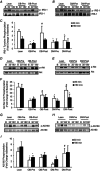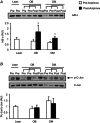Effect of a sustained reduction in plasma free fatty acid concentration on insulin signalling and inflammation in skeletal muscle from human subjects
- PMID: 23529132
- PMCID: PMC3690693
- DOI: 10.1113/jphysiol.2012.247510
Effect of a sustained reduction in plasma free fatty acid concentration on insulin signalling and inflammation in skeletal muscle from human subjects
Abstract
Free fatty acids (FFAs) have been implicated in the pathogenesis of insulin resistance. Reducing plasma FFA concentration in obese and type 2 diabetic (T2DM) subjects improves insulin sensitivity. However, the molecular mechanism by which FFA reduction improves insulin sensitivity in human subjects is not fully understood. In the present study, we tested the hypothesis that pharmacological FFA reduction enhances insulin action by reducing local (muscle) inflammation, leading to improved insulin signalling. Insulin-stimulated total glucose disposal (TGD), plasma FFA species, muscle insulin signalling, IBα protein, c-Jun phosphorylation, inflammatory gene (toll-like receptor 4 and monocyte chemotactic protein 1) expression, and ceramide and diacylglycerol (DAG) content were measured in muscle from a group of obese and T2DM subjects before and after administration of the antilipolytic drug acipimox for 7 days, and the results were compared to lean individuals. We found that obese and T2DM subjects had elevated saturated and unsaturated FFAs in plasma, and acipimox reduced all FFA species. Acipimox-induced reductions in plasma FFAs improved TGD and insulin signalling in obese and T2DM subjects. Acipimox increased IBα protein (an indication of decreased IB kinase-nuclear factor B signalling) in both obese and T2DM subjects, but did not affect c-Jun phosphorylation in any group. Acipimox also decreased inflammatory gene expression, although this reduction only occurred in T2DM subjects. Ceramide and DAG content did not change. To summarize, pharmacological FFA reduction improves insulin signalling in muscle from insulin-resistant subjects. This beneficial effect on insulin action could be related to a decrease in local inflammation. Notably, the improvements in insulin action were more pronounced in T2DM, indicating that these subjects are more susceptible to the toxic effect of FFAs.
Figures




Similar articles
-
Chronic reduction of plasma free fatty acid improves mitochondrial function and whole-body insulin sensitivity in obese and type 2 diabetic individuals.Diabetes. 2014 Aug;63(8):2812-20. doi: 10.2337/db13-1130. Epub 2013 Dec 18. Diabetes. 2014. PMID: 24353180 Free PMC article.
-
Effect of a sustained reduction in plasma free fatty acid concentration on intramuscular long-chain fatty Acyl-CoAs and insulin action in type 2 diabetic patients.Diabetes. 2005 Nov;54(11):3148-53. doi: 10.2337/diabetes.54.11.3148. Diabetes. 2005. PMID: 16249438 Clinical Trial.
-
Effects on insulin secretion and insulin action of a 48-h reduction of plasma free fatty acids with acipimox in nondiabetic subjects genetically predisposed to type 2 diabetes.Am J Physiol Endocrinol Metab. 2007 Jun;292(6):E1775-81. doi: 10.1152/ajpendo.00624.2006. Epub 2007 Feb 13. Am J Physiol Endocrinol Metab. 2007. PMID: 17299078 Clinical Trial.
-
Nutritional effects of fat on carbohydrate metabolism.Best Pract Res Clin Endocrinol Metab. 2003 Sep;17(3):399-410. doi: 10.1016/s1521-690x(03)00032-0. Best Pract Res Clin Endocrinol Metab. 2003. PMID: 12962693 Review.
-
Free fatty acids in obesity and type 2 diabetes: defining their role in the development of insulin resistance and beta-cell dysfunction.Eur J Clin Invest. 2002 Jun;32 Suppl 3:14-23. doi: 10.1046/j.1365-2362.32.s3.3.x. Eur J Clin Invest. 2002. PMID: 12028371 Review.
Cited by
-
Effect of Telmisartan or Losartan for Treatment of Nonalcoholic Fatty Liver Disease: Fatty Liver Protection Trial by Telmisartan or Losartan Study (FANTASY).Int J Endocrinol. 2013;2013:587140. doi: 10.1155/2013/587140. Epub 2013 Aug 13. Int J Endocrinol. 2013. PMID: 23997767 Free PMC article.
-
Serum Free Fatty Acid Concentration Predicts ARDS after Off-Pump CABG: A Prospective Observational Study.Lung. 2024 Oct;202(5):523-532. doi: 10.1007/s00408-024-00704-3. Epub 2024 May 16. Lung. 2024. PMID: 38753182
-
Muscle atrophy in patients with Type 2 Diabetes Mellitus: roles of inflammatory pathways, physical activity and exercise.Exerc Immunol Rev. 2016;22:94-109. Exerc Immunol Rev. 2016. PMID: 26859514 Free PMC article. Review.
-
Targeting NAD+ in Metabolic Disease: New Insights Into an Old Molecule.J Endocr Soc. 2017 May 15;1(7):816-835. doi: 10.1210/js.2017-00092. eCollection 2017 Jul 1. J Endocr Soc. 2017. PMID: 29264533 Free PMC article. Review.
-
Insulin-Stimulated Muscle Glucose Uptake and Insulin Signaling in Lean and Obese Humans.J Clin Endocrinol Metab. 2021 Mar 25;106(4):e1631-e1646. doi: 10.1210/clinem/dgaa919. J Clin Endocrinol Metab. 2021. PMID: 33382888 Free PMC article.
References
-
- Bajaj M, Suraamornkul S, Kashyap S, Cusi K, Mandarino L, DeFronzo RA. Sustained reduction in plasma free fatty acid concentration improves insulin action without altering plasma adipocytokine levels in subjects with strong family history of type 2 diabetes. J Clin Endocrinol Metab. 2004;89:4649–4655. - PubMed
-
- Belfort R, Mandarino L, Kashyap S, Wirfel K, Pratipanawatr T, Berria R, Defronzo RA, Cusi K. Dose-response effect of elevated plasma free fatty acid on insulin signaling. Diabetes. 2005;54:1640–1648. - PubMed
-
- Boden G, Lebed B, Schatz M, Homko C, Lemieux S. Effects of acute changes of plasma free fatty acids on intramyocellular fat content and insulin resistance in healthy subjects. Diabetes. 2001;50:1612–1617. - PubMed
-
- Chavez AO, Lopez-Alvarenga JC, Tejero ME, Triplitt C, Bastarrachea RA, Sriwijitkamol A, Tantiwong P, Voruganti VS, Musi N, Comuzzie AG, DeFronzo RA, Folli F. Physiological and molecular determinants of insulin action in the baboon. Diabetes. 2008;57:899–908. - PubMed
-
- Clore JN, Allred J, White D, Li J, Stillman J. The role of plasma fatty acid composition in endogenous glucose production in patients with type 2 diabetes mellitus. Metabolism. 2002;51:1471–1477. - PubMed
Publication types
MeSH terms
Substances
Grants and funding
LinkOut - more resources
Full Text Sources
Other Literature Sources
Medical
Research Materials
Miscellaneous

